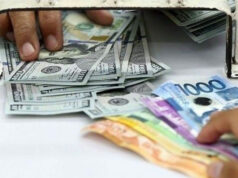BSP stays policy as 2019 draws to a close
THE BANGKO SENTRAL ng Pilipinas (BSP) kept monetary policy settings steady, as earlier signaled, in its eighth and last policy review for the year on Thursday, citing “a benign inflation environment.”
BSP Governor Benjamin E. Diokno said in remarks to reporters at the central bank headquarters in the City of Manila that “the Monetary Board decided to maintain the interest rate on the BSP’s overnight reverse repurchase facility at four percent… the interest rates on the overnight deposit and lending facilities… unchanged at 3.5% and 4.5%, respectively.”
Headline inflation hit successive multi-year highs last year, averaging a near-decade-high 5.2% in 2018 and forcing monetary authorities to increase benchmark interest rates by a total of 175 basis points (bps) in a bid to tame price pressures.
Inflation has since been on a decline, averaging 2.5% in the 11 months to November, well within the central bank’s 2-4% target range for this year.
With last year’s interest rate increases partly unwound by a cumulative 75 bps reduction this year, Mr. Diokno had told reporters on Dec. 3 that monetary policy easing could resume early next year. The central bank will hold its next policy review on Feb. 6.
On Thursday, monetary authorities also maintained the lowered 2.4% inflation forecast they had adopted in their Nov. 14 policy review, down from 2.5% previously. They also maintained their forecast for 2020 and 2021 at 2.9%.
“… [T]he balance of risks to the inflation outlook continue to lean slightly toward the upside in 2020 and toward the downside in 2021,” Mr. Diokno said on Thursday, citing as sources of near-term risk “potential volatility in international oil prices amid geopolitical tensions in the Middle East as well as from the potential impact of the African Swine Fever outbreak and recent weather disturbances on domestic food prices.”
At the same time, subdued global economic activity and demand amid the nagging Sino-US trade war “could… mitigate upward pressures on commodity prices.”
Monetary authorities also slashed banks reserve requirement ratio (RRR) by a total of 200 bps last year and by 400 bps more this year — bringing them to 14% for universal and commercial lenders, four percent for thrift banks and three percent for rural banks — as the BSP moved to bring this ratio closer to single-digit level by 2023, when Mr. Diokno ends his term in July that year.
The central bank chief — who had said last week that gross domestic product (GDP) growth could clock in this quarter at 6.4-6.5%, compared to the muted 5.6%, 5.5% and 6.2% in the first to third quarters — said on Thursday that economic growth stands a chance of hitting the lower end of the state’s target for 2019.
“Sustained policy support from increased fiscal spending, as well as improved liquidity conditions owing to recent monetary adjustments, is… expected to support growth in the coming months,” Mr. Diokno said.
Wednesday had seen the Development Budget Coordination Committee trim this year’s GDP target to 6-6.5% from 6-7% previously, as well as the goal for 2021 and 2022 to 6.5-7.5% from 7-8% originally, thus giving up on the eight percent aspiration by the end of the six-year term of President Rodrigo R. Duterte. However, they maintained the 2020 target at 6.5-7.5%.
For Euben Paracuelles, chief ASEAN economist at Nomura Holdings, Inc., the country could bank on continued implementation of infrastructure projects to sustain above-six percent GDP growth over the medium term.
In a conference call on Thursday on Nomura’s 2020 Asia Outlook, Mr. Paracuelles said: “I would point out that sustainability of this 6%-plus growth has been primarily due to the fact that there has been a bit of prioritization on infrastructure implementation.”
“This obviously has a direct impact on growth and, over the long term, it provides a boost to potential growth.”
In Nomura’s latest report, Asia in 2020: Glass half full and half empty, the country was seen to be an “exception” in the region as it expected to sustain GDP growth at six percent this year, picking up to 6.7% next year and then edge up to 6.8% in 2021.
“(Philippines) is the lone exception in Asia in terms of growth trajectory. We’re seeing a V-shape pick-up in growth rather that the U that we see elsewhere, primarily driven by infrastructure implementation of the government, we think that is a very strong priority,” Mr. Paracuelles said.
ANALYSTS LOOK AHEAD
ING Bank-N.V.-Manila Senior Economist Nicholas Antonio T. Mapa said that the decision to maintain policy rates could prop up the peso in the short term.
“Given the central bank decision to pause, we maintain our call for further peso appreciation bias to end the year on seasonal flows from overseas Filipino migrants, although the recent sell-down in the local equity market could limit the peso’s gain,” he said in a note sent to reporters.
Security Bank Corp. Chief Economist Robert Dan J. Roces said that the pause lets BSP observe the “appropriateness of the reduction it has so far imposed relative to the inflation path as it unwinds rate hikes from last year.”
“Better credit growth and possible resumption of monetary easing in 2020 should positively affect domestic economic growth,” he said in a note sent to reporters.
For UnionBank of the Philippines, Inc. Chief Economist Ruben Carlo O. Asuncion, the central bank may resume easing moves as early as the first half of 2020 “at 50 bps more.”
“Major factors would be inflation expectations, global oil price movements, and the impact so far of 2019’s easing on market liquidity and credit growth,” he said in a mobile phone message. — Luz Wendy T. Noble and Beatrice M. Laforga



